The Cultural Resonance of Native American Drum Beats
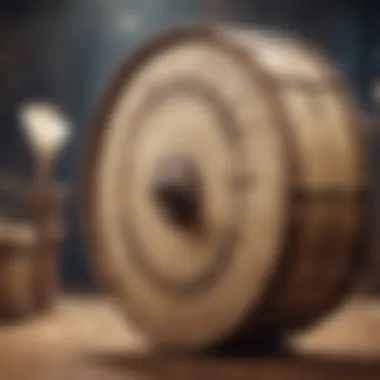
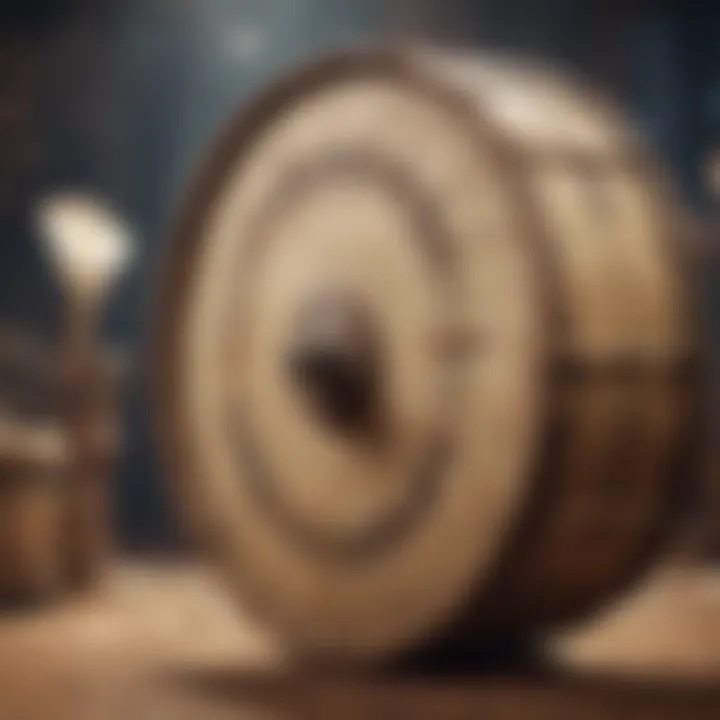
Intro
Native American drum beats hold a unique space in the musical landscape. They intertwine history, emotion, and spirituality, resonating with those who have the privilege to hear them. The drums, often hand-crafted from natural materials, create vibrations that not only carry music but also stories and traditions passed down through generations.
These rhythms play a crucial role in various tribal ceremonies, communal gatherings, and storytelling sessions. The art of drumming connects people, inviting them to share in a collective experience that goes beyond mere sound. Through understanding these beats, we can grasp the essence of Native American culture and heritage.
Artist Profile
Biography and Background
An exemplary figure that embodies this tradition is Kevin Locke. Born in South Dakota, Locke is a Lakota artist who has dedicated his life to the preservation of Native American music. From a young age, he immersed himself in the rhythms and songs of his ancestors.
His background is rich with influences from the Lakota culture, infusing his work with authenticity. Locke not only plays the drum, but he also integrates storytelling into his performances, showcasing the deep connection between music and narrative.
Major Influences and Inspirations
Locke’s inspirations stem from various domains—nature, spirituality, and indigenous history. Often, he reflects on the sounds of the earth, how the wind rustles through the pine trees or the gentle flow of rivers. His soundscapes are products of these observations, capturing the essence of the natural world.
Drumming isn’t just about rhythm for Locke; it encapsulates a form of communication. He draws from the experiences of his people, drawing parallels between historical events and contemporary issues. This approach creates a bridge between the past and the present, ensuring that the legacy of Native American music continues to thrive.
"The drum is a heartbeat; it is a connection to life and the spiritual universe around us." – Kevin Locke
The Role of Rhythm in Native American Culture
Rhythm is the backbone of Native American music, formed by a combination of drum beats and vocals. Its significance extends into various aspects of life, serving as a marker for celebrations, mourning, healing rituals, and spiritual journeys. Different tribes employ distinct rhythms, often characterized by specific types of drums like the powwow drum or the hand drum.
Types of Drums Used
- Powwow Drums: Typically played in large groups, these drums bring people together during powwows. They create powerful, thunderous sounds that echo across open grounds.
- Hand Drums: Smaller and often more personal, hand drums are used for individual performances or intimate ceremonies. They allow the player to express deeper emotions.
- Frame Drums: Often associated with women, these are used in sacred songs and prayers. They produce softer tones but resonate with equal spiritual depth.
In understanding the types of drums and their uses, one appreciates how rhythm serves as a communal language, providing a platform for collective expression.
Synthesizing the Insights
Exploring the depth of Native American drum beats offers a unique lens to view not just music, but a culture steeped in rich tradition. Artists like Kevin Locke illustrate this beautifully, captivating audiences with their profound storytelling and rhythmic prowess.
As we unpack the layers of rhythm, historic context, and cultural sentiment, the drum emerges not merely as an instrument but as a living artifact, echoing centuries of human experience and connection. \n Through this exploration, we gain insight into not only the music, but the heart and soul of a people who have long cherished their heritage. Through their rhythms, they invite us into their world, one beat at a time.
Historical Significance of Native American Drumming
The importance of understanding the historical significance of Native American drumming cannot be overstated. Drumming serves not only as a form of musical expression but also as a vital thread connecting Indigenous peoples to their heritage, culture, and spirituality. The drum, often referred to as the heartbeat of Mother Earth, carries rich symbolism and meaning that surpasses mere rhythm. For music enthusiasts, aspiring musicians, and students, delving into these historical contexts becomes crucial when appreciating the full depth of Native American drumming traditions.
Origins of Drum Use
The origins of drum use among Native American tribes are as varied as the tribes themselves. Evidence suggests that drums were utilized in North America for thousands of years, likely serving communal purposes in spiritual rituals, celebrations, and gatherings. Many tribes believed that the drum was a gift from the spirits, meant to facilitate communication with the spiritual realm.
Drums were often crafted from natural materials, such as animal skins and wood, with each tribe having its own unique design and sound. For example, the Lakota used drums as essential instruments in their sun dances and healing ceremonies, while the Navajo incorporated them into their chantways, highlighting their cultural practices.
Drumming in Pre-Columbian Cultures
Before European contact, Native American cultures flourished across the continent, each with its own distinct practices and drumming styles. Many tribes used percussion instrumentation as a foundational element in their social fabric. This rhythmic aspect fostered unity and cooperation within communities.
In ceremonies, drumming often accompanied singing and dancing, creating an immersive vibrant experience that helped to reinforce cultural narratives and communal identity. Noteworthy is the Great Plains' ceremonial drums, which often played significant roles in events like the powwow—a gathering that celebrates Native culture.
Adaptations in Colonized Contexts
The arrival of European settlers brought challenging changes to Indigenous practices, including drumming. Many Native American communities faced oppression, leading to adaptations in their musical practices. Some tribes had to disguise their rituals and rhythms to avoid persecution, often blending their traditions with those of their colonizers.
However, indigenous drumming found a way to endure. Styles were modified, and new techniques emerged amid the colonial pressures. Over time, the drum evolved to incorporate modern instruments while maintaining the essence of Native American rhythms. In recent years, there has been a resurgence of interest in these traditional beats. Many contemporary Native American musicians seek to reclaim their heritage and educate younger generations about the importance of drumming in their culture.
"Drumming is not just an act; it is an experience that transcends the physical realm and connects you deeply with your roots."
Cultural Context of Drum Beats
The cultural context of drum beats in Native American societies is not just an artistic expression; it embodies a rich tapestry of history, identity, and spirituality. Drumming is often regarded as the heartbeat of a community, resonating deeply at various social and ceremonial junctures. Whether it’s a rite of passage, a harvest celebration, or a spiritual invocation, drums play a critical role in uniting people, telling stories, and maintaining cultural legacies. Such context is vital for understanding how these important musical elements influence and shape the community dynamics.
Drumming in Ceremonies and Rituals
Drumming occupies a sacred space in ceremonies and rituals among Native American tribes. These gatherings are often rich with symbolism, offering windows into spiritual beliefs and traditions. The drumming serves more than just a musical function; it becomes a conduit through which the community communicates with the spiritual world. For instance, in the powwow tradition, drums provide the rhythm for dances that honor ancestors and the natural world, reinforcing a sense of connection and continuity. Many tribes believe that the sound of the drum mimics the heartbeat of Mother Earth, creating a powerful synergy between humans and nature.
"The drum is not just an instrument. It’s a voice, a guide, and a place where the spirit of our ancestors lives on."
In these contexts, wild animals and seasonal changes dictate the timing of rituals, and the drum’s rhythm often evolves with the changing environment, reflecting the interconnectedness of life.
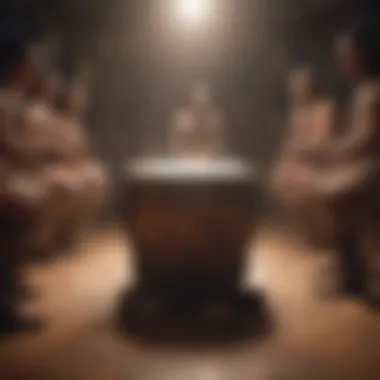
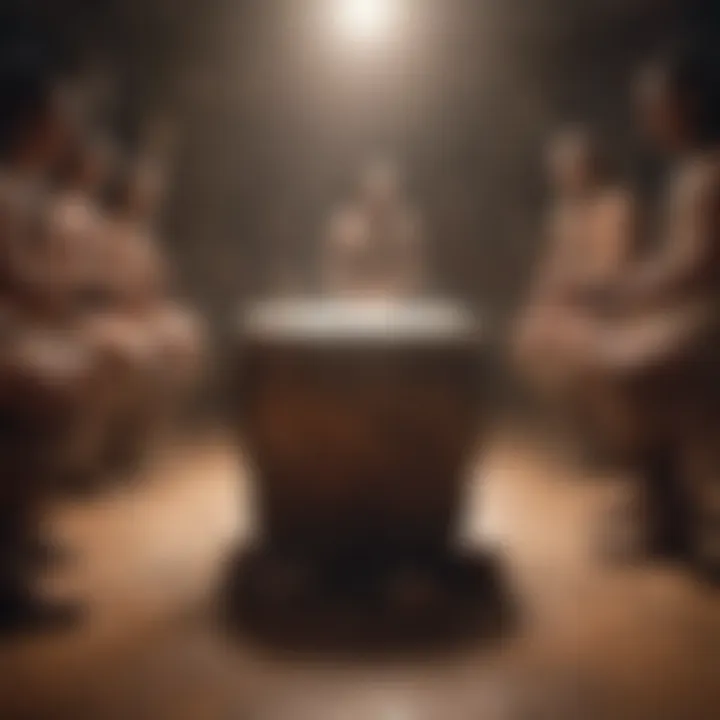
Role of Drumming in Community Identity
The act of drumming is critical in forming community identity. Each tribe has distinct rhythms and styles, with drums that reflect their unique histories and cultural narratives. This differentiation is essential; it promotes a sense of belonging and pride among members. Drumming gatherings are often communal events where young and old come together, emphasizing collective participation and shared values. In these settings, the rhythms learned become stories passed down through generations, tying individual identities back to the broader tribal narrative.
For example, the Lakota Sioux utilize drumming as a means of expressing resilience and solidarity, especially during gatherings that commemorate historical events. Here, the beating of the drum fosters a collective experience, engendering feelings of hope and continuity within the tribe.
Influence on Native American Language and Stories
Drumming has not only musical significance but also a linguistic and storytelling dimension. Many stories are woven together with rhythms, where specific drum patterns may accompany particular tales. The cadence and pace of the beating drum can change the tone of a story, guiding the listener’s emotion and engagement. This interplay enriches the oral tradition, as many tribes use drumming as an integral part of their storytelling practices.
Moreover, various drum rhythms can symbolize different narratives or tribal identities. New generations often learn these patterns alongside language, embedding cultural knowledge and linguistic nuances in their understanding of the world. For instance, those learning the Navajo language may find that certain drumbeats serve as mnemonic devices, reinforcing the connection between sound, story, and community values.
In essence, Native American drum beats serve as a profound instrument for cultural expression, pivotal in ceremonies, community identity development, and the continuation of literary traditions. Their beats are the sounds of life itself, echoing the stories and resilience of Indigenous cultures across generations.
Characteristics of Native American Drums
Drums hold a unique place in Native American culture, serving not just as musical instruments, but as symbols of identity, tradition, and community. This section delves into the characteristics that define Native American drums, focusing on their diverse types, the construction materials used, and the distinctive sounds they produce. Understanding these aspects provides insight into the broader cultural and spiritual significance of drumming within Native American communities.
Types of Drums Used
Water Drums
Water drums are remarkable both in their construction and sound. These drums are often made from a hollowed-out log placed in water, which serves to amplify the sound. Their key characteristic lies in the deep, resonant tones they create, which are said to mimic the sounds of nature. Such drums are frequently used in spiritual ceremonies, making them a popular choice for rituals that call for a profound connection to the elements. The unique feature of water drums is their ability to change pitch depending on the water level, allowing for a versatile range of sounds. However, they can be challenging to transport and maintain due to their reliance on water, but their spiritual resonance often outweighs this inconvenience.
Hand Drums
Hand drums, notably smaller and more portable, are played with the hands, rather than sticks. This category varies widely, from the simple frame drums to more complex structures like the powwow style drums. Their key characteristic is their ability to produce a rhythm that feels deeply personal, as they are often played close to the body. In this article, hand drums highlight the benefit of intimacy in performance, allowing for a more direct connection between the drummer and the spirit of the music. A downside might be that they require specific techniques to achieve different sounds, which can demand significant practice to master.
Frame Drums
Frame drums are among the oldest types of drums used in Native American music, characterized by their circular shape and lack of a head. They can be made with various materials, including animal skins and synthetic alternatives. One key characteristic that stands out is their lightweight nature, making them convenient for travel and performance anywhere. These drums are often used in storytelling and dance, enhancing the narrative experience. A unique feature of frame drums is their ability to be played in various ways—tapping, rubbing, or striking with the hand. Though they are generally easy to use, achieving a wide range of dynamics may require different techniques, which can be a bit of a learning curve for new players.
Construction Materials and Techniques
Natural Materials
Using natural materials is a hallmark of Native American drumming. Many drums are crafted from wood, animal skins, and fibers that have cultural significance. Key characteristics of these materials include their connection to the earth and sustainability, reflecting a respect for nature that pervades Native American culture. This choice benefits the physical structure of the drum, offering a warm timbre that synthetic materials often lack. However, relying on natural resources means that the drums need careful maintenance to prevent damage from the elements, which might be considered a disadvantage.
Traditional Craftsmanship
Traditional craftsmanship in drum-making is an art that has been passed down through generations. This method emphasizes hand-made techniques that immmerse the maker in a deep cultural practice. The key characteristic here is the attention to detail which ensures not only functionality but also an expression of cultural identity. Such craftsmanship becomes essential as it signifies the community's heritage, making each drum unique in its story and sound. Nevertheless, the time-consuming nature of crafting drums traditionally might pose a limitation in today’s fast-paced world, potentially affecting continuity and practice.
Distinctive Sounds and Rhythms
The distinctive sounds and rhythms that Native American drums produce are essential to their cultural relevance. Each type of drum contributes to the unique musical language, creating a rich tapestry of sound that resonates deeply within the community. The rhythms are not just a backdrop but often carry specific meanings, connecting to spirits and ancestral songs.
"Rhythm is the heartbeat of Native American music, echoing the connection between the drummer and the earth."
Understanding these rhythms offers further insight into how they are utilized within ceremonies, celebrations, and gatherings, forming the heartbeat of these communities.
The Role of Rhythm in Native American Music
Rhythm stands as the backbone of Native American music, acting as the heartbeat of communal gatherings, rituals, and celebrations. It's not just a sequence of beats; it conveys stories, emotions, and cultural heritage. When drummers take their place, they are not only performing but also participating in an ancient dialogue that connects past and future generations. The significance of rhythm extends beyond mere timekeeping; it forms a bridge between the material world and the spiritual realm.
Understanding the Importance of Rhythm
At its core, rhythm is a vital instrument for expressing identity in Native American communities. It shapes individual and collective perceptions, drawing them together into a unified entity, creating unity among people. Furthermore, rhythm can set the stage for specific ceremonies, allowing participants to enter a trance state, achieving a form of transcendence. For instance, during a powwow, the distinct drum beats help to synchronize dancers and evoke a shared response that resonates throughout the crowd.
It’s worth noticing that every pattern and tempo has a meaning, whether it be celebratory or somber. The deliberate choices made in the drumming patterns reflect not only historical stories but also present-day experiences of Native American life. Without grasping the intricacies of rhythm, one might as well be standing outside, misreading an ancient text that speaks to the soul.
Patterns and Structures in Drumming
The patterns in Native American drumming are intricate and varied, often influenced by regional styles and traditions. Each tribe may have its unique style that embodies historical and spiritual narratives. For instance:
- Straight Beats: Common in many tribal ceremonies, straightforward rhythms establish a predictable foundation that allows other elements—like voices and movements—to soar.
- Syncopation: Surprising accents and irregular rhythms can stimulate emotional responses, pushing dancers to new heights of expression.
- Polyrhythms: Some ensembles feature multiple drummers, creating a rich tapestry of overlapping rhythms. These can foster a communal feel while giving each drummer their own space to shine.
Drummers often change patterns during performances to elevate the engagement level, signaling transitions and bringing life to the event in a way that mere words may fail to express. This deep understanding of rhythm influences how a piece is remembered and evolves as each drummer leaves their mark.
Interplay Between Drums and Vocals
In Native American music, the interplay between drums and vocals creates a lush soundscape, rich with meaning. It’s like the dance of two old friends, where drums provide the cornerstone while vocals interlace melodies that stir the heart. Traditionally, vocalists might chant or sing stories that reflect their environment and experiences, the drums providing a pulse that brings the narratives to life.
This relationship is symbiotic in nature. The voice can guide the drum—to soar high or to echo low, emphasizing certain elements of the performance. In turn, the rhythm can inspire the direction a song takes, often leading to spontaneous improvisation that captivates both performers and audience alike. Drumming cues shifts in vocals, whether to signal the end of a verse or to encourage a solo flourish that showcases individual talent.
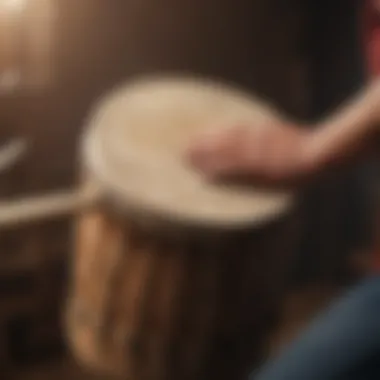
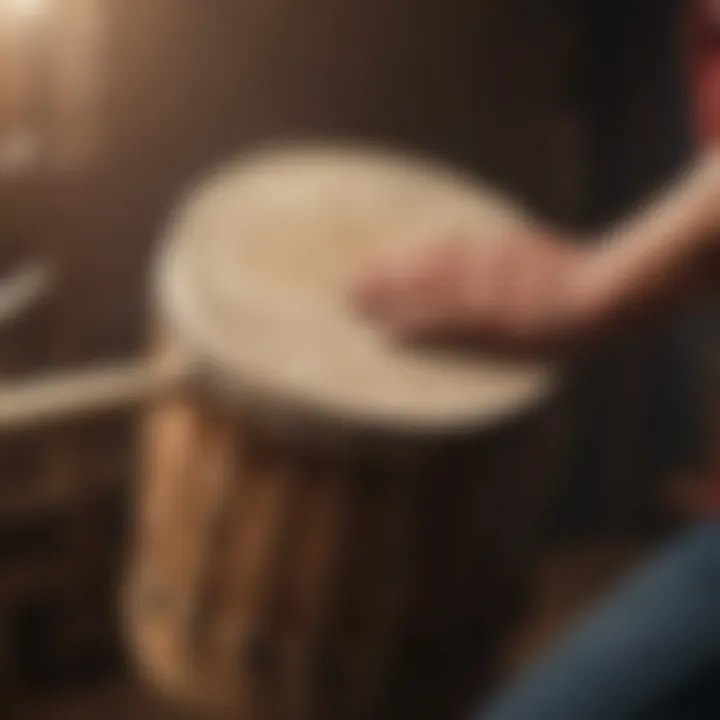
"Rhythm is the soul of Native American music, harmonizing tradition and innovation in every beat."
As a result, the collective experience during performances is enriched, weaving together the past, present, and future into a seamless narrative fabric. The exchange between drums and voices encapsulates the heart and soul of Native American culture, inviting listeners to participate in a larger conversation.
Spiritual Dimensions of Drumming
The spiritual facets of drumming within Native American culture resonate deeply and serve as a profound connection to the natural world and personal introspection. These rhythms are not merely a form of entertainment or art; they embody a pathway through which individuals seek communion with both the earth and the universe. For Native American communities, drumming communicates the pulse of life, a heartbeat that ties every living entity together.
Connection to the Earth and Nature
In many tribes, the drum symbolizes the earth itself. Its round shape mirrors the cyclical nature of life and the interconnectedness of all beings. Each beat echoes the heartbeat of Mother Earth, reminding the player and listener of their place within the broader tapestry of life.
Drumming often takes place outdoors in natural settings, further reinforcing this bond. The sounds blend seamlessly with the rustle of leaves, the flow of water, or the whispers of the wind. It’s believed that this connection helps individuals tap into the energies of nature, allowing for a deeper understanding of their surroundings and self. The spiritual connection deepened through drumming facilitates grounding experiences, acting as a reminder of the responsibilities we have to the land and each other.
As one travels the path of these drum beats, they can sense not just the rhythm but also the essence of the environment surrounding them. For instance, the Hopi people, in their drumming, often reflect themes of growth and connection, emphasizing how the earth nurtures life.
Drumming as a Tool for Meditation and Healing
Drumming acts as a medium for meditation, leading practitioners into a space of serenity and mindfulness. The rhythmic patterns created can resonate within one’s being. This auditory experience tends to quiet the mental chatter; thoughts settle like dust in a still room.
Many Native American traditions use drumming in healing ceremonies. The consistent beat fosters a trance-like state, which, in conjunction with intentions set by the participants, stimulates profound healing—both physically and emotionally. In this context, drum circles become sanctuaries where individuals come together to share their struggles and aspirations. Each beat can symbolize a release—an expenation of pain, sorrow, or personal history.
For instance, the practice of using a water drum, which utilizes the sound of water as an integral component of its rhythm, has a unique healing aspect. Participants often report feeling a significant emotional release or rejuvenation after engaging in such sessions.
Sacred Symbols and Meanings
In Native American culture, the drum carries various sacred symbols that add depth to its significance. Each tribal community imbues their rituals and music with distinct meanings that are closely tied to their history and cosmology.
Common symbols include:
- Circle: Represents eternity, the cycle of life, death, and rebirth.
- Heartbeat: Symbolizes unity with the earth and every living organism.
- Sound Waves: Convey communication with the spirit world and serve as a bridge between realms.
The act of drumming becomes a sacred ritual where participants honor not only their ancestral traditions but also the spirits of the land. Special ceremonies often involve blessings for the instruments themselves as well as the players. It is customary to acknowledge the materials used, expressing gratitude for the gifts of nature that create the drums, from the animal hides to the wood.
"Drumming is our voice and our language. It speaks to the earth, the sky, and our spirit. Each beat is a conversation, a connection."
Through these symbols and practices, the drum elevates from a musical instrument to a sacred conduit, allowing participants to connect with deeper existential layers of their identity and the universe.
Understanding the spiritual dimensions of drumming enriches one's appreciation of Native American heritage and emphasizes the discipline's relevance in contemporary contexts. These beats hold stories and traditions that transcend time, fostering a continuity of culture that thrives today.
Prominent Native American Drummers
The exploration of Native American drum beats can’t ignore the pivotal figures who have championed this rich tradition. Prominent Native American drummers have played a key role in shaping not only the rhythms but also the narratives surrounding indigenous music. Their contributions extend beyond mere performance; they serve as historical anchors, cultural ambassadors, and innovative artists who continue to inspire generations.
Contemporary Influencers
In the current musical landscape, several modern drummers stand out as influential voices in Native American music. Notable examples include:
- R. Carlos Nakai: A master of the Native American flute, Nakai blends traditional melodies with Native drum beats, creating a sound that's both meditative and enriching. His work has broadened the audience for Native music, drawing listeners who might not have previously engaged with the culture.
- Kevin Locke: An educator, storyteller, and performer, Locke integrates drumming with his performances to elevate the cultural story behind the music. His enthusiasm for the connection between drumming and Native identity is palpable, as he often shares the importance of rhythms from various tribes.
- Nikki DeLoach: This singer and drummer has a knack for fusing contemporary styles with traditional rhythms, inviting a younger generation to appreciate authentic Native American sounds.
These artists, along with others, not only showcase the diversity found in contemporary drumming but also highlight how the beats are a powerful conduit for storytelling and cultural transmission.
Historical Figures
Historical drummers provide a foundational context for understanding modern rhythms. Figures like Buffalo Child Long Lance, a well-known author and performer in the early 20th century, showcased the significance of drums during public performances. Similarly, Willie Dunn, known for his act of blending drumming with activism, carried the weight of indigenous issues in his music. In their time, these individuals modeled what it meant to preserve tradition while adapting to contemporary themes, ensuring that drumming remained relevant in both cultural and social dialogues.
"The drum is the heartbeat of the community, just as the stories are the veins carrying the lifeblood."
Such statements capture the essence of the work done by these historical drummers, emphasizing the intrinsic connection between rhythm and culture in Native American context.
Collective Contributions to Music Culture
The cumulative impact of these drummers—both modern and historical—cannot be overstated. They have:
- Preserved traditional rhythms that might have otherwise faded into obscurity.
- Innovated new styles by blending traditional drumming with various genres, thereby creating a unique sound that resonates on global stages.
- Promoted educational efforts aimed at teaching younger generations about the historical significance of drums. This includes workshops, school demonstrations, and community gatherings where the beats echo as more than just music—they become lessons in heritage.
Ultimately, the legacy of Native American drummers is a testament to the endurance of cultural expression through artistic innovation. Their involvement in the music culture serves as a bridge, connecting the past with the present while continuing to inspire future musicians.
Influence of Native American Drumming on Contemporary Music
The impact of Native American drumming reverberates through modern music like ripples on a pond. Recognizing this influence is essential, as it serves as a bridge between ancient traditions and contemporary sounds. Drumming not only enriches musical diversity but also creates a dialogue about cultural heritage that resonates with today’s audiences. In this context, it’s vital to explore how traditional beats have melded with current genres, influenced popular musicians, and played a significant role in activism.
Fusion with Modern Genres
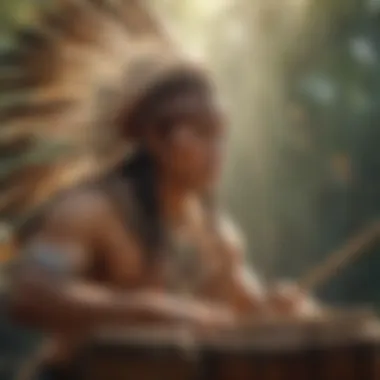
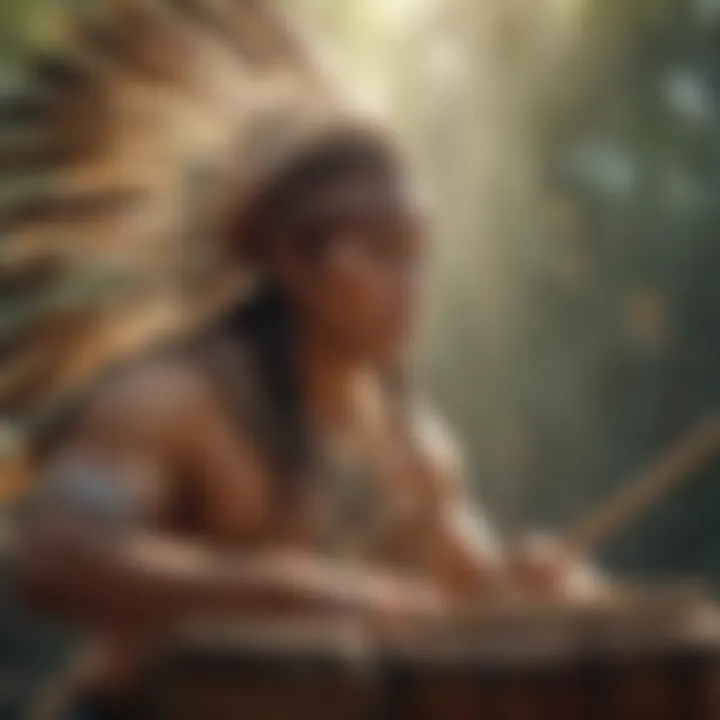
The blending of Native American drumming with modern genres reflects a living cultural evolution. Artists are increasingly incorporating traditional rhythms into styles like rock, hip-hop, and electronic music. A prime example is the work of artists like Robbie Robertson, who has expertly woven the heartbeats of traditional drumming into rock melodies.
Additionally, the creation of tracks that feature hand drums promotes cross-cultural collaborations. This fusion has birthed vibrant sub-genres, allowing contemporary musicians to rethink rhythm, melody, and cultural narratives.
- Native drum patterns can be found in various hits today, showcasing their rhythmic versatility.
- Many musicians are inspired by the drumming styles, often using them as a foundation for their compositions.
- Collaborations, such as those between Native drums and urban beats, widen the audience, fostering appreciation of indigenous sounds.
While some purists might worry that fusion waters down traditions, it can also be seen as a vital path for preservation. By revitalizing interest, modern interpretations keep these sounds alive for future generations.
Integration in Popular Music Circles
The incorporation of Native American drumming in popular music offers a lens through which listeners gain insight into a rich cultural tapestry. Artists frequently sample traditional drum beats in their tracks, creating a bridge that connects diverse audiences.
For instance, artists like Buddy Red Bow and Keith Secola have made their mark in popular circles. Their music, infused with drumming patterns, has opened dialogues about Native American identity and resilience. The repetitive and trance-like quality of these beats captivates listeners, pushing them to engage not merely as consumers but as learners immersed in a culture that may be unfamiliar to them.
Popular music festivals often feature Native drummers, bringing visibility to their traditions and fostering a shared space for music lovers. A deeper understanding emerges when artists share the stories behind the rhythms they’re employing—allowing their work to function not just as art but as a cultural teaching tool.
Role in Activism and Awareness
Beyond its musical influence, Native American drumming plays a pivotal role in social movements and activism. Following the call of the drum, many communities have come together, using the music as a rallying cry for justice and recognition of indigenous rights.
In events such as the Women's March or gatherings focusing on land rights, drumming has become a powerful symbol. The rhythmic beats echo the heartbeat of the earth, reminding participants of their connection to nature and their communities. This engenders solidarity and instills a sense of purpose.
"The drum is more than an instrument; it’s a voice for those who have been silenced."
Drumming also creates awareness of pressing issues, like climate change and preservation of sacred lands. By integrating these beats into protest songs and performances, artists like Buffy Sainte-Marie bring urgency and a creative heartbeat to their message.
Preservation of Native American Drumming Traditions
Preserving Native American drumming traditions is crucial for maintaining the cultural identity and heritage of various tribes across North America. Drum beats are not merely sounds but are extensions of the communities that create them. Through the drum, ancient stories are shared, values are transmitted, and connections to spiritual beliefs are deepened. In an ever-modernizing world, the necessity of keeping these traditions alive is underscored by several key factors.
One significant element is the sense of community that drumming fosters. It brings people together, serving as a rallying point for shared cultural values. This communal aspect cannot be overstated — drumming is often the heart of gatherings, ceremonies, and rituals. Therefore, the loss of drumming practices would equate to a weakening of tribal cohesion.
Furthermore, preserving these traditions allows future generations to understand and appreciate their cultural roots. By ensuring that the rhythms, techniques, and songs are passed down, younger members of communities gain a sense of identity and belonging. This transmission of knowledge not only enriches their lives but also fortifies the tribe's broader cultural narrative amid modernization and globalization.
Another layer to consider is how these drumming traditions encapsulate history. Each beat often carries the weight of ancestral messages, histories of struggle, and triumph, embedding stories into the very fabric of each rhythm. As contemporary society embraces diverse influences, recognizing these histories becomes even more essential in fostering a sense of respect and understanding towards Native American cultures.
These facets highlight that the preservation of Native American drumming is more than just about the music; it encompasses a profound sense of identity, community, and continuity. Keeping these traditions alive ensures that the wisdom and experiences of past generations echo into the future.
Challenges in Modern Context
The modernization of society presents several challenges to the preservation of Native American drumming traditions. Urbanization often leads to the dissipation of these cultural practices, as younger generations move to cities, faced with the pressures of contemporary life. The time and space for communal drumming or gathering might diminish, resulting in traditions being pushed to the periphery.
Additionally, there’s a risk of cultural appropriation where external influences might misrepresent or dilute the drumming practices, stripping them of their intended meanings. This misrepresentation can lead to misunderstanding and disrespect towards Native American cultures. Educating the public about the authenticity and significance of these traditions becomes paramount, lest they become mere novelties.
Intensive competition with mainstream music also cannot be ignored. With the allure of pop culture and commercialized music, many young musicians might prioritize trending genres over traditional forms. The busy schedules of modern life do not always accommodate the practice and performance of traditional drumming, leaving these ancient rhythms in the shadows.
Efforts by Communities and Organizations
Despite the challenges, numerous initiatives are in place aimed at preserving Native American drumming traditions. Many tribes focus on reviving drumming through community programs and workshops that engage younger members in the learning process. These programs teach the historical significance and context of the drum, allowing the youth to feel its pulsing heartbeat within their own lives.
Organizations such as the Native American Music Association help promote traditional music through festivals and events, creating platforms for indigenous artists to showcase their talents. > "Preservation isn’t just about keeping traditions alive; it’s about making them vibrant and relevant to today’s generation."
Cultural centers also play a role by hosting regular drum circles where everyone, regardless of background, can come together to learn and participate. This inclusivity fosters an environment of understanding and respect while continuously tying back to the community’s roots. These efforts not only strengthen tribal bonds but also educate non-Natives about the beauty and depth of these traditions.
Educational Initiatives
Education serves as a vital tool in the preservation of Native American drumming. Numerous schools and colleges are now incorporating indigenous music studies into their curricula. This educational focus ensures that students learn not just the how of drumming, but the why, embedding cultural narratives and ideals into their understanding of the practice.
Workshops and classes led by experienced drummers help dispel myths surrounding indigenous music while teaching proper techniques and meaning behind various rhythms. Programs dedicated to inter-generational learning where elders teach the youth foster a mutual exchange of knowledge, honor ancestral traditions, and reinforce community ties.
In essence, preserving Native American drumming traditions involves a multi-faceted approach: facing modern challenges head-on, leveraging community efforts, and embedding education within the framework of tribal identity. Each element adds complexity and richness, ensuring that the drum beats resonate through generations to come.
Ending
The exploration of Native American drum beats holds vital importance not only as a musical journey, but also as a means of understanding cultural identity and heritage. Through the lens of rhythm and sound, we gain insight into the ways these beats reflect the histories, traditions, and spiritual landscapes of Native American communities. This conclusion synthesizes the crucial elements discussed throughout the article, focusing on the significance of preserving these traditions and the lessons they impart.
Recapitulation of Key Insights
In our discussion, we navigated through the historical significance of drumming, examining its origins and adaptations in various contexts. We explored the cultural dimensions that place drumming at the heart of ceremonies, rituals, and communal identity. The article highlighted distinct characteristics of Native American drums, showcasing types and construction methods while capturing the unique sounds they produce. Moreover, we delved into the vital role rhythm plays within the broader scope of Native American music, illustrating connections to both nature and spirituality.
By profiling prominent drummers and acknowledging their contributions, we learned how these artists help keep traditions alive in a rapidly changing world. Furthermore, we investigated the impact of contemporary influences on Native American drumming, addressing efforts to bridge the past and present while sustaining cultural practices.
Future Directions for Research and Exploration
As we look ahead, the path for future research in this area is rich with possibilities. There is a pressing need to document oral histories and personal narratives that articulate the experiences of drummers across generations. This would not only preserve the art but provide platforms for diverse voices within Native communities. Additionally, exploring the integration of technology in drumming practices could reveal new dimensions of innovation while respecting traditional forms.
Collaboration between musicians, scholars, and community members can add depth to our understanding of how drum beats resonate in today’s multicultural landscapes. Programs encouraging education on drumming in schools and universities can initiate discussions surrounding cultural appreciation and sensitivity.
Overall, as we ponder the rhythms of Native American drums, it becomes clear that these beats are more than mere sounds. They are rich narratives interwoven with history, community, and spirituality, crying out to be heard. As awareness grows, just as the heartbeat of a drum, so too can our appreciation and efforts to ensure these traditions endure for future generations.







